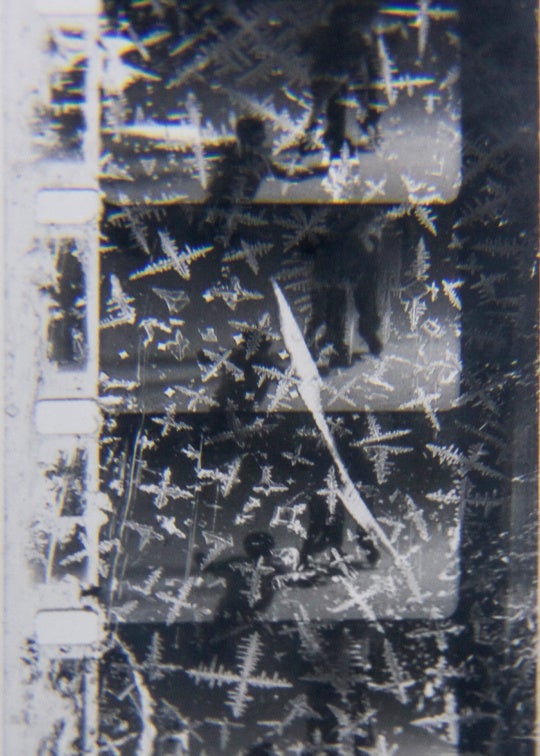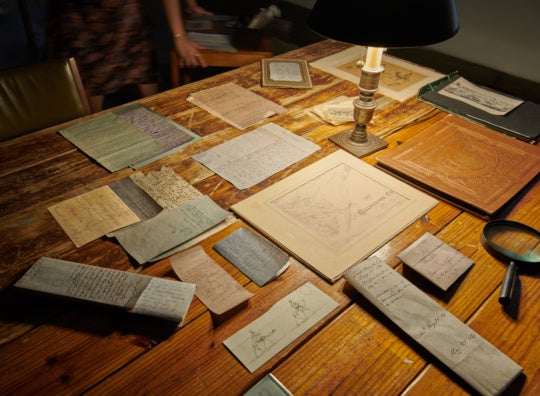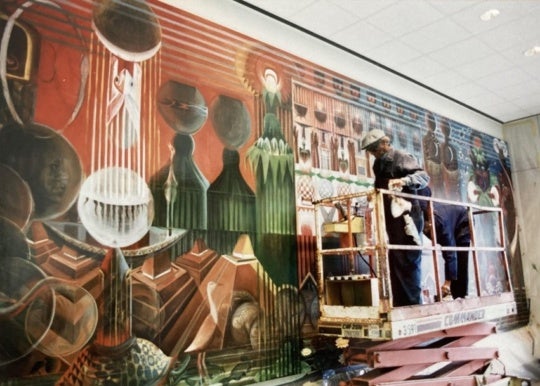
George Long’s show Mimic opened on a perfect spring evening, the kind of warm night where twilight lasts for ages and the breeze smells like the ocean. As I entered Marcia Wood Gallery, I was met with paper renditions of woodpiles pasted on the wall below Ramparts, a work on wood panel. The faggots of sticks were as inviting as a campfire of imaginary friends in a clearing, and reminiscent of cabin trips with my family that never happened. If I seem overly wistful or nostalgic for an imaginary past, it’s because that’s what these works encouraged.
Long’s new work features the outlines of children in various states of play or interaction. These uniform depictions of children, all boys, have the soft features and coiffed blonde hair reminiscent of an illustration from the 1950s. The drawings seem to be tapping into that same idealized Americana, where all the major characters are white, and engage in ‘normal,’ idyllic past-times. The scenes are a substitute for the viewer’s memories of childhood, evoking wistful contemplation.

Yet there’s something unsettling about these drawings. This is in part due to incongruous images scattered among the children. In Threadbare, children play innocently on a woodpile, but a man in the foreground diverts our attention; he stands facing the viewer, leaning on a cane. He is bald and plump, seemingly middle-aged. His presence is disconcerting—why is he there among the children, yet separate from them? Is he watching them? Is he watching us? In these idyllic settings, anything that seems out of place becomes ominous. Even the faint bowl of fruit in Mimic seems foreboding (or maybe I’ve just watched this spoof on Werner Herzog too many times).
Long’s process also adds an element of discomfort to these artworks. The artist took original drawings and transferred them through stamping, tracing, and repeated copying onto paper and panel. The repetition blurs the original images; each print is less clear than the previous. In works like Stifler, images of young boys are layered, some fainter than others, making it difficult to tell if they are actually different children or if it’s a single boy moving across time, like a long-shutter photograph. Several figures are almost unintelligible; attempts to make sense of the scene are as frustrating as trying to recall a memory. Indeed, the faint layering of the images coupled with the nostalgic renderings makes these drawings like memories—malleable and incomplete, and subject to reordering and filling holes with false patches. Long’s process of transferring blurs and erases elements of the original image, continuing to change and distort it like an old memory, faded and manipulated over time.

When read as memories, a sense of unease permeates the works. The ambiguous space left by the blurred and incomprehensible elements of these scenes is foreboding. These images seem like memories purposefully tampered with, rather than merely forgotten. When confronted with this realization, the viewer must question why these memories have been distorted and partially lost. Are these fragmented scenes violent memories that were suppressed long-ago? If these works are a stand-in for our own childhood memories, was there something terrible that we ourselves tried to forget?
A chill sets in; the idyllic scenes of our supposed pasts have become forcibly forgotten traumatic events, haunting us with hints of violence. We want to know what happened, but fear what we might find. Perhaps it’s best not to know.
George Long’s Mimic will remain up at Marcia Wood Gallery through June 9, 2012. The gallery is open Tuesdays, Thursdays, and Saturdays from 11AM to 6PM, and Wednesdays and Fridays from 1 to 6PM.




